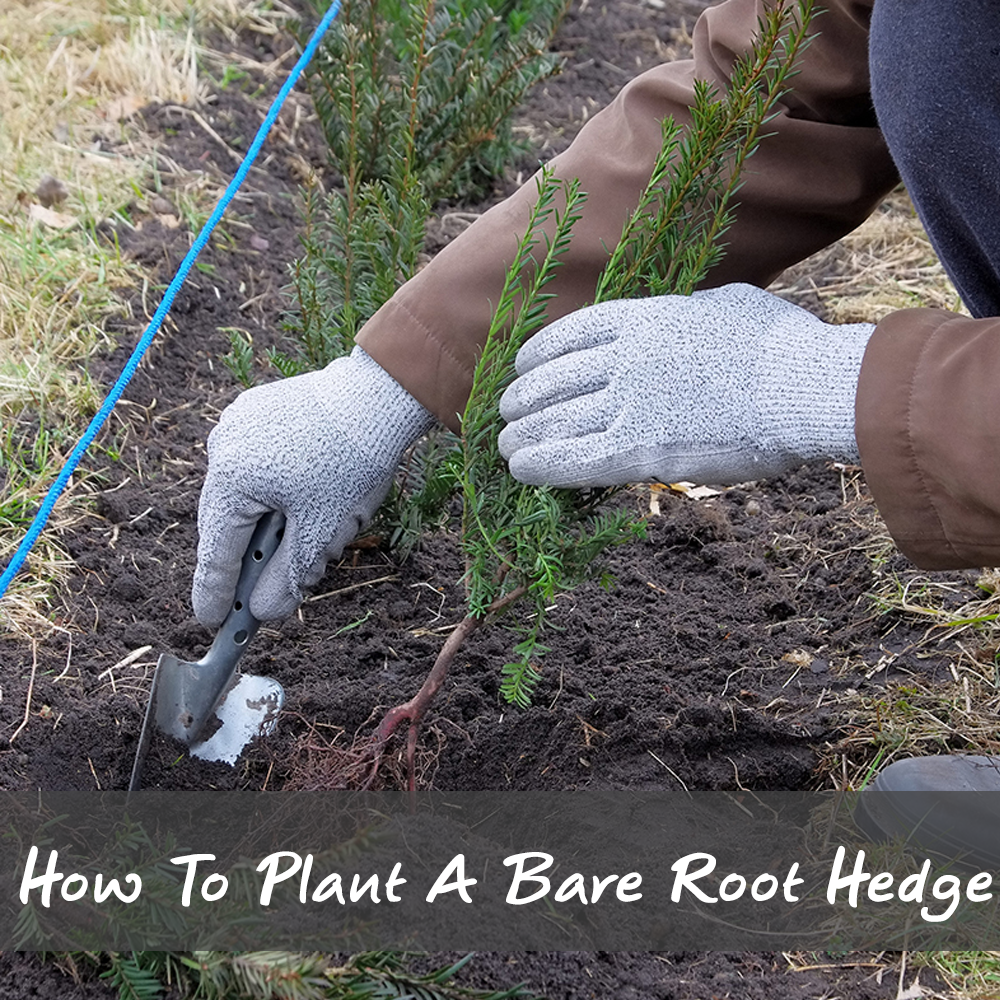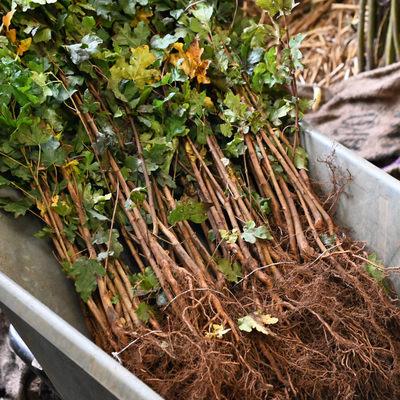Bare-root hedging is one of the most cost effective and easiest ways to create lush foliage come spring.
Whether you’re looking for some added privacy to enjoy your space in peace or want to add a beautiful feature to your garden, our guide to planting bare-root hedges will help you achieve it.
We’ll walk you through how to get the job done and when the best time is to do it, as well as providing tips on aftercare and keeping your hedge looking healthy for many years to come.
Contents
What are the benefits of planting a bare-root hedge?
When is the best time to plant a bare-root hedge?
Should I plant a single or double-row hedge?
How to plant a bare-root hedge
How to care for your new hedge
How long does a bare-root hedge take to grow?
When can I prune my new hedge?
What is a bare-root hedge?
Bare-root hedges are plants grown in the ground in nurseries, which are dug up when dormant in early autumn. They are then prepared and packaged in handy bundles without soil around their roots – hence the name ‘bare-root’ plants!
To learn more about the main ways hedge plants are sold, including pot-grown hedges and root-balled hedging plants check out our guide.
What are the benefits of planting a bare-root hedge?
- Cost — Using bare-root plants to start a hedge is a cheaper alternative to container-grown plants. Because bare roots do not contain much soil, they are lightweight and easier to transport, lowering their price.
- Quick root establishment — Bare-root plants can quickly acclimate to new soil conditions. This means that the roots are fast to establish, giving them a head start on growing.
- More environmentally friendly — In contrast to container-grown plants, which need pots, bare-root plants only need soil, limiting the use of plastic.
When is the best time to plant a bare-root hedge?
Although bare-root hedges can be planted between October and February, doing this early in the autumn will give the roots the best chance of establishing. This will ensure they are strong enough to support stem and leaf growth in spring.
Avoid planting during:
- Icy or snowy conditions — Once buried, the ice or snow will stay frozen for months, slowing the time it takes for your roots to establish or even killing your plants.
- Wet weather — During rainy conditions, soil can become waterlogged due to compaction, possibly hindering root growth.
- Very windy conditions — Wind can rock your plants, creating air holes in the soil and exposing drying winds to the root, limiting growth.
Should I plant a single or double-row hedge?

Whether you should plant a single or double row will depend on how thick you want your hedge to be, how much screening you desire, and how much space you have.
Planting a double-staggered row will create a dense, bushy hedge, while single-row hedges are thinner, making them ideal for smaller gardens.
How to plant a bare-root hedge
Planting a bare-root hedge is a fairly easy procedure that requires very few tools. We’ll walk you through our simple steps to get the job done.
To get started you’ll need:
- Bare-root hedging plants
- A garden spade
- Soft string or spine
Method
- Prepare your hedge

Your hedge roots must stay moist, so try not to leave them out of the soil for longer than a few days. Once it arrives, pop the hedge bundle in a bucket of water and soak it for at least a couple of hours to rehydrate the roots.
If you’re unable to plant your hedge in this time frame, put it in a bucket with moist compost covering the roots. This will ensure the roots keep healthy until you’re ready to plant, which can help to get your hedge off to a good start.
- Dig the trench
First, prepare the site by digging a v-shaped trench with a space deep enough to comfortably fit all the roots. Make sure you leave at least 30cm on either side to allow the plant to spread while it grows.
Remove any weeds to allow all the water and nutrients to go directly to your hedge.
- Prepare your plant fertiliser
Using a plant fertiliser like Rootgrow is recommended to encourage plant establishment and promote healthy growth.
Fill a bucket with water and follow the instructions on the packet.
- Mark the area with string
Place a long piece of string along your trench where you plan to place your hedges. This will help you to position your plants in a straight line.
- Place your hedging plants
Dip your plant roots into the fertiliser, place them into your trench, and repeat.
Aim to place three to seven plants per metre into your trench, depending on whether you are using a single or staggered double row. Increase the number of plants depending on how dense you need the hedge to be.
- Backfill the area
Once your hedging plants are placed, backfill the trench by putting the soil back into the hole using a spade. Spread in an even layer around six inches high and press down gently with your foot or the back of your spade to compact it. Repeat these steps until the trench is full. Make sure all the roots are covered but the stem is still exposed.
Be careful not to over-compact it as this could damage the plant’s root systems.
- Water each plant
Give your plants their first water at their base and continue to do so around twice a week for the first year.
How to care for your new hedge
- Make sure your hedges have space
Weeds and long grass need to be kept away from your hedge for the first two to three years of planting. This will ensure your new plants get the space they need to obtain nutrients, light, and moisture, keeping them healthy and maintaining growth.
- Water often

How often you need to water your hedging plants will depend on the weather: monitor regularly to ensure they don’t dry out during hot conditions or become waterlogged in wet weather. It’s particularly important to keep on top of this during the first year. Evergreen hedging plants, like yew and cherry laurel, also benefit from spraying their foliage.
Thoroughly water your plants at their base to allow the water to get to the roots. Doing this in the evening will ensure the sun doesn’t evaporate the water.
- Protect from the wind
Windy conditions may rock new plants, exposing the roots to drying winds or letting frost in. To prevent your plants from drying out before the roots are established, gently press down the soil with your foot when needed. Or, put up some windbreak netting if the winds are particularly strong.
- Fertilise in spring
Fertilising your hedging plants during spring will encourage healthy growth as temperatures rise.
How long does a bare-root hedge take to grow?
Bare-root hedges may take from three to seven years to reach the desired size. Taking proper care of your newly planted hedge and using fertiliser often during the initial months and years will encourage growth.
When can I prune my new hedge?
Newly planted hedges will often need pruning once a year and don’t need too much trimming immediately after planting. There are, however, various needs for different hedge species.
Most deciduous plants — Species such as hawthorn and blackthorn can be trimmed immediately. Doing this will encourage bushy new growth.
Evergreens — Some evergreen species don’t need to be cut back, including yew and cherry laurel. The side stems can be trimmed after around a year, but the main shoot shouldn’t be touched until your hedges have reached the desired height.

The best time to prune your hedge is early spring or wintertime, as for most plants, this is when the leaves will fall out. You’ll be able to see what you’re doing more easily and identify areas that need cutting back.
To learn more about trimming your hedge plant, read our guide.
Once you know how and when to plant, growing a bare-root hedge is simple. For more expert gardening advice, take a look at our blog.




my garden is very wet at the moment and I have just recieved 20 bareroot hawthorne plants, can I plant them now. If not what to do with them.
Hi Steven,
If the garden is waterlogged then we would suggest to hold off until the garden has dried a bit. If you dig out and there are water pools then no, if the soil is just wet then that’s fine to plant.
To store them we suggest to put them in a dark, cool place like a shed or a garage but not a green house and make sure they are regularly watered.
If you need any more advice please give us a call on 01257 788 248.